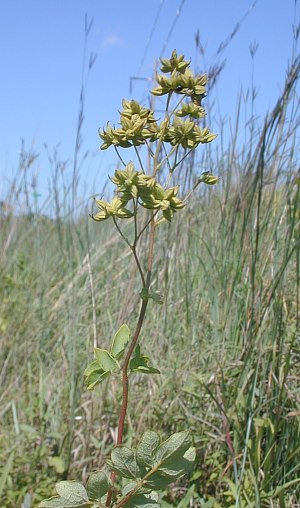Description: This perennial plant is 3-7' tall, branching occasionally. The central stem is rather stout, green or reddish purple, and glaucous or slightly pubescent. The alternate leaves are ternately compound: A primary compound leaf divides into 3 secondary compound leaves, while each secondary compound leaf has 3 leaflets. Each leaflet is about ¾–2" long and half as much across. It is rounded at the base, and either unlobed or with 2-3 lobes toward the outer edge (usually a large middle lobe and 2 smaller side lobes). The margin of each leaflet turns downward slightly. The light green or white lower surface has a waxy appearance that is covered with glandular hairs. These hairs will glisten when they are exposed to sunlight. The lower surface of a leaflet also has a reticulated network of conspicuous veins. The foliage, when crushed in the hand, will produce a skunk-like smell.

Occasionally, the upper
stems will produce panicles of flowers that are up to 2' long and about
half as much across. Individual plants are usually unisexual, producing
either male or female flowers. A male flower has 4-5 light green sepals
that spread outward, while conspicuous white stamens with yellow or
brown anthers occupy the center. Each male flower is about 1/3" long.
The male flowers usually droop downward from slender pedicels, and
together have an airy appearance that is rather pleasant. The female
flowers are shaped like small green burs and have numerous short
pistils. They are less attractive than the male flowers. The blooming
period is from late spring to early summer, and lasts about 3 weeks.
There is no floral scent. Pollination is by wind. The flowers are
replaced by small achenes that are ribbed and pointed at both ends. The
root system has rhizomes, which enables vegetative colonies to form.
This plant gradually dies down during the summer, but forms new
vegetation at the base during the fall.
Cultivation:
The preference is moist to slight dry conditions, and partial to full
sun. This plant usually grows in fairly typical garden soil, such as a
rich loam or clay loam. The height of a plant can vary considerably
depending on fertility of the soil, moisture conditions, and maturity.
Vegetative growth is very rapid during the spring. This species of
Meadow Rue appears to tolerate full sun and droughty conditions better
than most.

Range &
Habitat:
Waxy Meadow Rue is widely distributed in Illinois, where it is native.
This plant occurs
occasionally in central and northern Illinois, but it is less common or
absent in southern Illinois (see Distribution
Map). Habitats include mesic black soil prairies, thickets
and woodland borders, savannas, and areas along railroads and
roadsides, especially where remnant prairies occur.
Faunal Associations:
Because the flowers are wind-pollinated, few insects visit the flowers.
Occasionally bees gather pollen from the anthers of the male flowers,
while various kinds of beetles eat the pollen. Because the foliage has
a foul scent, it probably is not a preferred food source for mammalian
herbivores.
Photographic Location:
The photographs were taken at the Red Bison Railroad Prairie in Savoy,
Illinois. The plants were growing in full sunlight under mesic
conditions.

Comments: This plant is reasonably attractive while in bloom, but this doesn't last very long. The various Thalictrum spp. have very similar flowers, but can be distinguished by their foliage. Waxy Meadow Rue has glandular hairs on the undersides of the leaflets (which glisten in the sunlight), and the foliage has a foul scent when it is crushed. Another species, Thalictrum dasycarpum (Purple Meadow Rue), has a very similar appearance, but the hairs on the undersides of the leaflets (if present) are non-glandular, while the foliage has little scent. Either of these plants can occur in prairies. Another species that is fairly common in Illinois, Thalictrum dioicum (Early Meadow Rue), is a shorter plant that blooms earlier and occurs in woodlands. However, the terminal leaflets of this species have 5 lobes toward the outer margin, while the terminal leaflets of Waxy and Purple Meadow Rue have only 3 lobes.